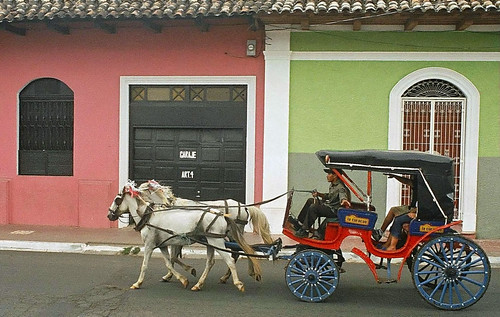
Ay Nicaragua Nicaraguita
Granada is the oldest colonial city in Nicaragua, located just at the northwestern tip of Lake Nicaragua. Granada is one of the most important cities in Central America, full of colonial and architectural heritage. While only the third largest city in Nicaragua, Granada is its tourism capital and has the country’s best architecture, museums, hotels, and restaurants that all give the city a charming colonial feel to it.
History
Granada was founded in 1524 by Francisco Hernandez de Cordoba. For much of the ensuing years, this colonial city served as an important commercial port because of its link to the Atlantic through Lake Nicaragua. Much of the gold and silver mined by the Spanish were transported to Granada and then unloaded on ships returning to Spain. As a result, Granada drew the attention of many British, French, and Dutch pirates and was attacked on a number of occasions.
Nevertheless, Granada’s strategic position allowed its economy to grow and develop, making the town’s elite wealthy. This made Granada a very conservative town and led to a rivalry with the more liberal Léon over the political direction of the country. This brooding between the two Nicaraguan cities resulted in many civil wars after Nicaragua achieved independence from Spain in 1821, but even in the heat of these conflicts in the 1980s, Granada escaped any major damage. Today, much of its colonial heritage and buildings remain intact with its colonial-era downtown being designated as a living museum.
Attractions
The main attraction of Granada is its elegant colonial architecture. Most impressive is the Iglesia de San Francisco, a former baroque convent that was built in 1529 and rebuilt after a fire in 1867. Today, it hosts art galleries and exhibitions of Nicaraguan paintings. Next to the convent is a museum with a collection of stone artifacts that date back to around 800AD; the archaeological items are all excavated from the ancient sites along the shores and isles of Lake Nicaragua.
A few other churches are just as historically and artistically interesting as Iglesia de San Francisco, among them the María Auxiliadora, Catedral de la Ascunción, and Iglesia de la Merced. Both the Catedral de la Ascunción and Iglesia de la Merced are famous for their association with the notorious American mercenary, William Walker, who tried to conquer Central America in the mid-1800s and actually managed to capture Granada in his quest. Both the Catedral de la Ascunción and Iglesia de la Merced were destroyed by Walker. While the Catedral de la Ascunción was completely destroyed, only the interior of the Iglesia de la Merced was damaged. This latter church was rebuilt on the inside, but its original 1781 façade remains.
Besides churches, you’ll find a number of colonial-style government buildings like the 1913 Palacio Episcopal and the Palacio Municipal, which is the city hall. Both the Palacio Municipal and the Palacio Episcopal are located in Granada’s central park, Parque Colón. At the Plaza de los Leones, you’ll find a charming 1809 stone building, the Casa de los Leones, which now houses Granada’s art and culture center. The building actually survived a fire set by Walker in 1856.
Lake Nicaragua
A little outside of the city is Lake Nicaragua, where many locals and tourists alike enjoy visiting. This lake is the tenth largest fresh water lake on earth and the only one that is inhabited by fresh water sharks. By the shores of the lake, there is an old Spanish fort, the Feurte de la Muelle. On the southern end of the lake, there is a waterfront park, Centro Turístico, which has several restaurants and recreational facilities. There are also tour operators and equipment rental shops where you can rent a boat (and other water equipment) and explore the lake and its islands.
Volcán Mombacho Natural Reserve
The Mombacho Volcano is about six miles south of Granada and part of the unique and protected cloudforest of the Volcán Mombacho Natural Reserve. There are hiking trails that circle the crater of the dormant volcano of Mombacho and the reserve is home to a diverse set of flora and fauna that includes 450 plant species, some 90 orchid varieties, and over 120 species of birds. Because the park is close to 4,500 feet above sea level, there are numerous panoramic views of the lakes, valleys, and villages below at various lookout points. It is recommended that you bring a jacket because the high altitude makes for a cool climate.
Shopping
Granada is famous for its rocking chairs, manufactured by the factories in suburban Masaya. At the local markets in the old market hall, you’ll find stands where you can purchase handicrafts, Nicaraguan pottery, hammocks, and other souvenirs.


Comments